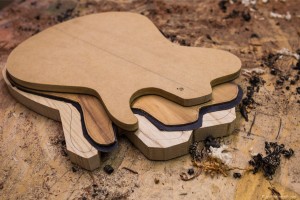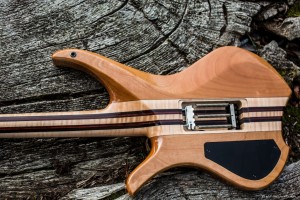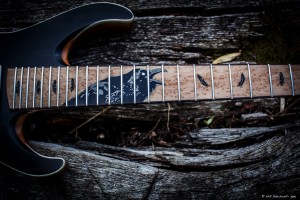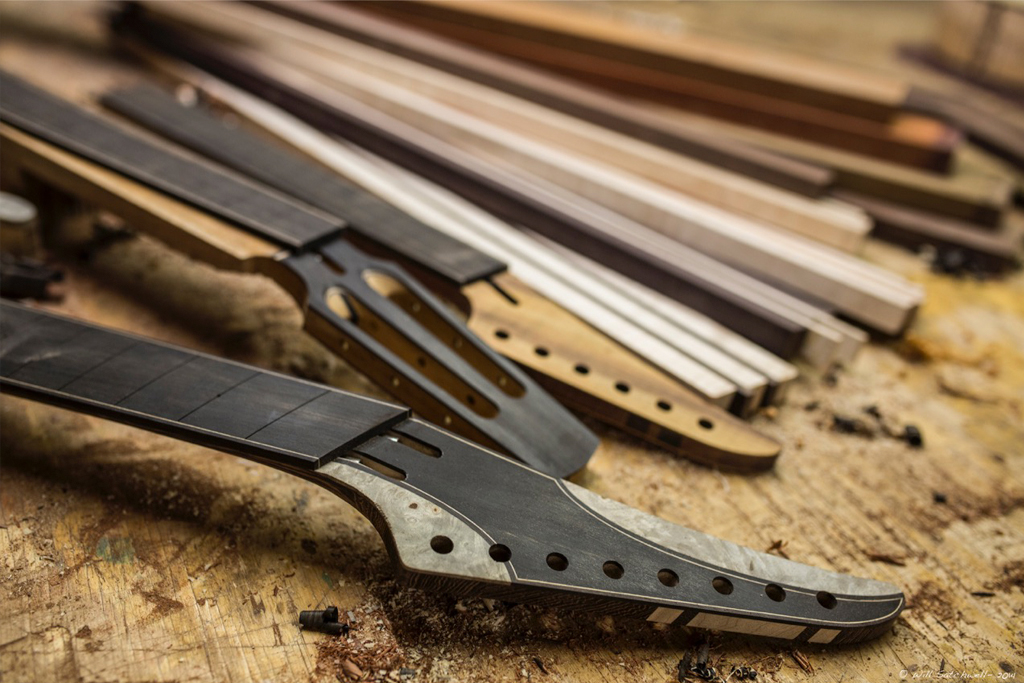Bodies
 Across the range of body shapes i offer i tend to keep a standard slimline thickness of 35mm as the norm. I have found that this is both comfortable and functional (for playability and weight), while not losing any tonal benefits.
Across the range of body shapes i offer i tend to keep a standard slimline thickness of 35mm as the norm. I have found that this is both comfortable and functional (for playability and weight), while not losing any tonal benefits.
There are times where we will make your body slightly thicker, to accommodate a floyd rose for instance, or if you specified a thicker body as it was your personal preference.
Necks, Fingerboards and Headstocks
 Necks are all carved by hand, without exception. I use a 30 year old spokeshave (that i bought second hand at a country wood fair) to carve each and every single neck i produce. I have found that the older the tools, the better they work. I will work closely with you to find exactly what kind of neck shape best suits you and your playing style. Where possible, i will have you visit the workshop once your neck is carved to approve the shape i have created for you. I feel that neck shapes are one of the single most important aspects of building a guitar to get exactly right. I will carve a neck until it feels ‘snug’ in the palm of my hand – once it gets in the correct area of comfort i will put it down and come back a day or two later to finish the carving and cleanup. I have found that having that time away from it really helps keep things clear and precise. Once it is at this stage i will contact you to book a visit (where possible). If you are an overseas customer and visiting isn’t an option that is fine, i will liaise closely with you to produce a neck that is exactly what you want.
Necks are all carved by hand, without exception. I use a 30 year old spokeshave (that i bought second hand at a country wood fair) to carve each and every single neck i produce. I have found that the older the tools, the better they work. I will work closely with you to find exactly what kind of neck shape best suits you and your playing style. Where possible, i will have you visit the workshop once your neck is carved to approve the shape i have created for you. I feel that neck shapes are one of the single most important aspects of building a guitar to get exactly right. I will carve a neck until it feels ‘snug’ in the palm of my hand – once it gets in the correct area of comfort i will put it down and come back a day or two later to finish the carving and cleanup. I have found that having that time away from it really helps keep things clear and precise. Once it is at this stage i will contact you to book a visit (where possible). If you are an overseas customer and visiting isn’t an option that is fine, i will liaise closely with you to produce a neck that is exactly what you want.
Fingerboards are all slotted by hand (using a traditional fret slotting saw) and then bound with (Maple veneer) and Ebony binding. I do also offer plastic binding on my fingerboards but (personally i dislike it) so i far prefer to use Ebony instead. The choice, however, is entirely yours.
My nut widths are as follows:
– 6 string: 42mm
– 7 string: 48mm
– 8 string: 54mm
Neck thickness tends to be 21mm behind the nut and 23mm behind the 12th fret, but this varies from guitar to guitar depending on what i am making.
There are three main headstocks that i currently offer on my electrics. They are simple shapes but they serve my needs and tastes well. Headstocks tend to be a place where i can have a little fun and get creative – I like to splice timbers together and create head veneers that are a little different from the norm. If this isn’t your thing that is fine – we can keep it simple. If it is something that appeals to you please let me know and we can create something that is personal to you and your instrument.
The reverse faces of headstocks on all of my guitars feature a veneer facing. More often than not this will be an Australian burl. Sometimes it will be a piece of ebony or sometimes it will match the timber of the fingerboard or the cap on your guitar. It all depends what will best suit your instrument as to what we use.
Neck Joints
 During the past few years of prototyping and finding which direction my luthiery wanted to naturally take me, i fast discovered that neck access joints were an ESSENTIAL part of the build to totally nail. You need plenty of space, while still offering maximum comfort. The carve needs to allow the player to achieve fast speeds without being restricted or confined in any way. I believe this is what i have achieved with my neck-through heel carve.
During the past few years of prototyping and finding which direction my luthiery wanted to naturally take me, i fast discovered that neck access joints were an ESSENTIAL part of the build to totally nail. You need plenty of space, while still offering maximum comfort. The carve needs to allow the player to achieve fast speeds without being restricted or confined in any way. I believe this is what i have achieved with my neck-through heel carve.
Again, as with all of my neck carving, all of my heel carves are done entirely by hand and are carved until they feel ‘snug’ in the palm of my hand. There is a sweet spot that i aim for when carving, and i carve until it feels right. Once i hit that sweet spot the carve is done.
My set-neck and bolt-on carves are very similar and offer a comparable comfort to that of my neck-through heel carves, though obviously, do have slightly more mass compared to that of my neck-through’s. Again, they are all done entirely by hand and are carved until they sit snugly in the palm of my hand. Comfort is king when it comes to access carving.
Scale Lengths and Extended Range
Standard scale length on my 6 string electrics is 25.5″ unless otherwise requested. My 7 string scale lengths can be anywhere 25.5″ to 27″ it is entirely up to you. As long as your preference will function correctly, i am happy to make it.
With regard to things like multiscales, i have spent a fair bit of time prototyping and going through quite rigorous R&D to find the happy medium for setting average numbers to such things. With 7 strtings i favor a 25.5″ – 27″ scale, with a perpendicular 7th fret.
And with 8 strings i prefer 26″ – 28″ scales with a perpendicular 8th fret. These are my ‘standard numbers’ that i will work to when building multiscales.
If you wished to have something different please feel free to submit an order form and specify what changes you would like. Like i said before, if your preference differs from my norm that is fine. Assuming it will function correctly, i will be happy to make it.
Inlay
 Inlay is my favorite medium in everything i do. It is where i truly feel free to create something that is an extension of myself and my creativity. My inlay skills are entirely self taught and have not been easy to come by.
Inlay is my favorite medium in everything i do. It is where i truly feel free to create something that is an extension of myself and my creativity. My inlay skills are entirely self taught and have not been easy to come by.
All of my inlay work is done by hand. With the exception of pearl dots which are purchased precut, every single piece of pearl or stone i inlay into one of my guitars will have been cut and filed clean by me.
If you have an idea for something simple, or for something so elaborate you think it to be impossible, please get in touch – chances are i will want to inlay it for you.
Finishing
Up until recently i was lacquering all of my own instruments. My father has been in the motor trade for over 40 years and has spent the last 10+ years teaching me how to spray.
Sadly, i have recently had to take the decision to be outsourcing all of my clear coating lacquer work from now on purely because i cannot afford to spend so much time on just one stage of a guitars creation. It is not a decision i have taken lightly, but one i have had to make when being realistic with what i am capable of and what kind of throughput i need to produce to stay in business.
The standard lacquer used on all of my instruments is Polyester. It is an exceptionally durable lacquer (which is very well suited to the gigging/touring musician) that can achieve an almost unbelievably high level of gloss finish when used correctly. It is ideal for my needs so it is all i offer. Please do not ask for Nitro Cellulose (or anything else) as your request will be politely refused.
As well as the Polyester based lacquer finish, i also offer oil finishing too. An oil finished guitar feels like nothing else. While it offers very little in the way of durability or protection, it offers an exceptionally comfortable closeness with the wood that you just cant find with anything else.
As a standard, if you decide to go for an oil finish your guitar will have at least 8-15 hand applied coats of danish oil.






